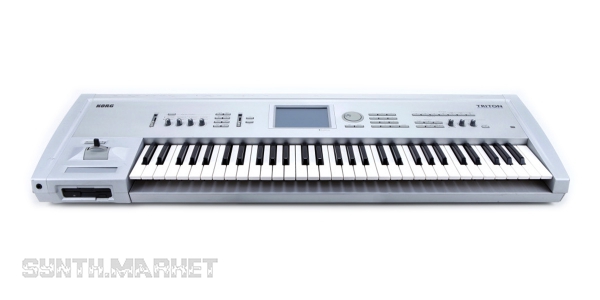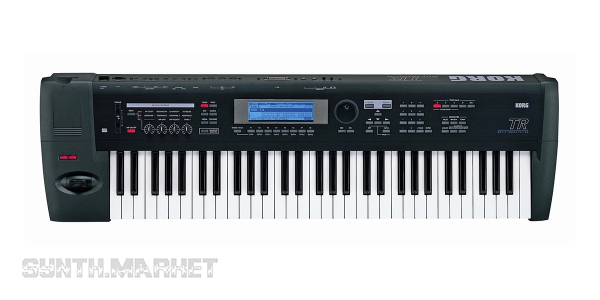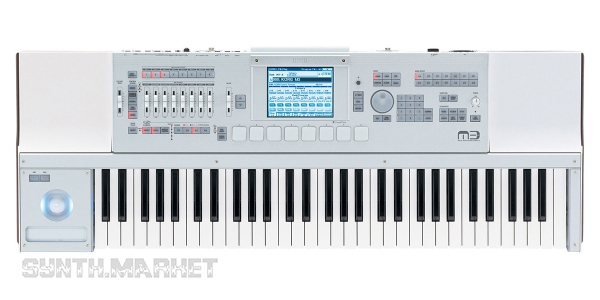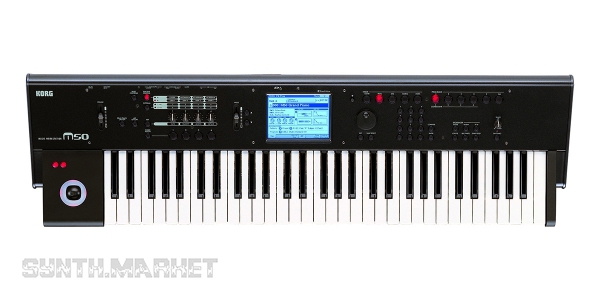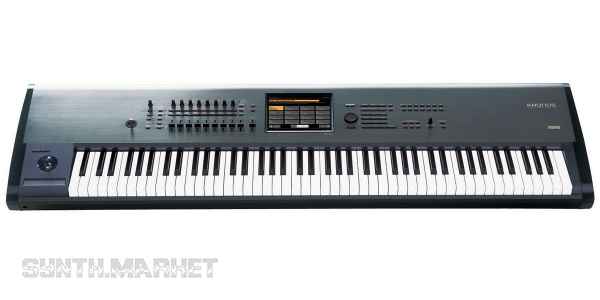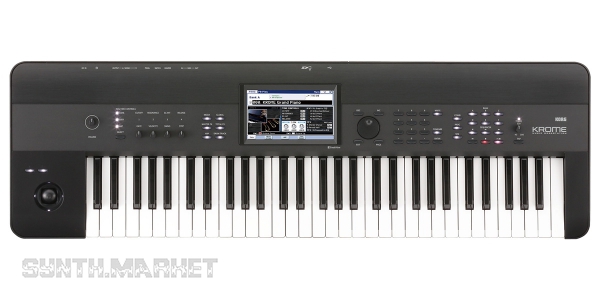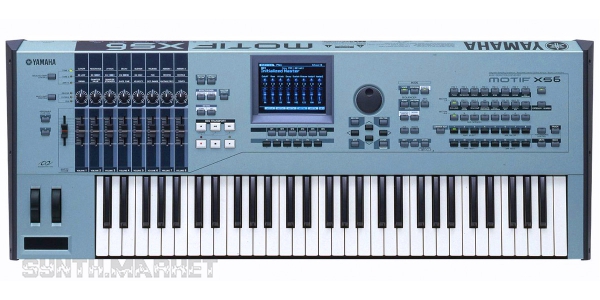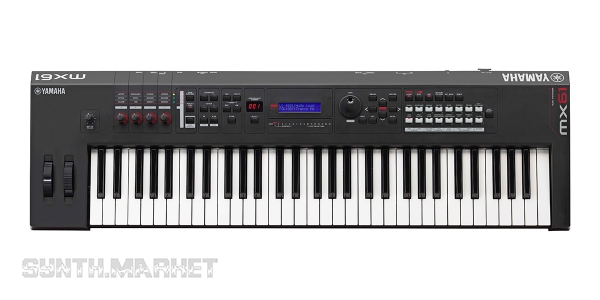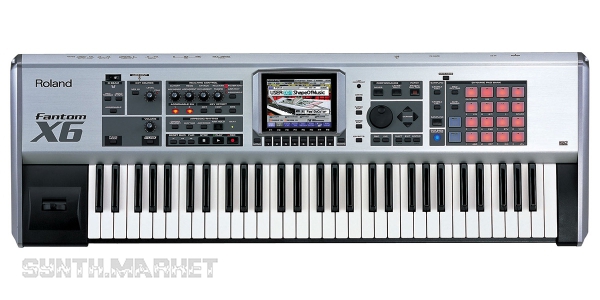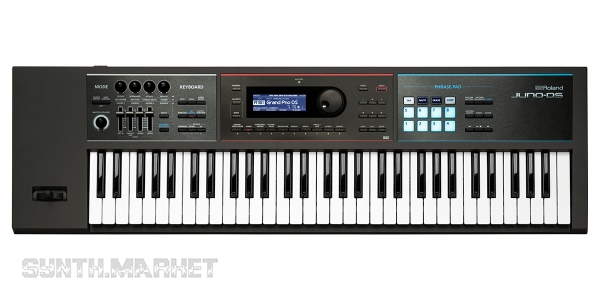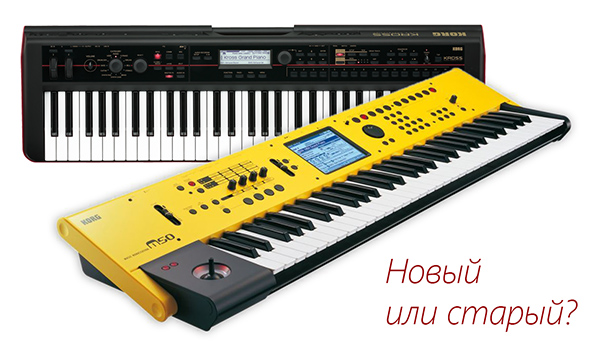 The interdependence between active marketing and large scale production of such huge corporations as Korg, for example, is obvious and quite natural. A popular and respectable brand which still wants to keep it running will never agree to be forever content with the only (even if it’s that startling) product which brought commercial success – it may be as popular as it used to be and hit the list of bestselling second hand synths but as soon as the company stops releasing it gets branded as “retro”. The manufacturer may turn to be a dead-page of the history by launching the same series again and again offering irksome updates or by cutting and expanding the same piece of structure. The company tries its best offering a product which meets at least the basic market needs in order not to find itself catching lazily the stagnant air in the shadow of its own success. To put it simply, sometimes big companies release the products not because they want to but because they need to – as a result we have quite an applicable and fine (and often a little bit more compact and affordable) instrument but essentially it’s a blank product with a clearly void idea which can be easily replaced by any other similar type. Popular brands just have to respect these checkpoints in order to maintain their top positions and provide their engineers and marketers with work.
The interdependence between active marketing and large scale production of such huge corporations as Korg, for example, is obvious and quite natural. A popular and respectable brand which still wants to keep it running will never agree to be forever content with the only (even if it’s that startling) product which brought commercial success – it may be as popular as it used to be and hit the list of bestselling second hand synths but as soon as the company stops releasing it gets branded as “retro”. The manufacturer may turn to be a dead-page of the history by launching the same series again and again offering irksome updates or by cutting and expanding the same piece of structure. The company tries its best offering a product which meets at least the basic market needs in order not to find itself catching lazily the stagnant air in the shadow of its own success. To put it simply, sometimes big companies release the products not because they want to but because they need to – as a result we have quite an applicable and fine (and often a little bit more compact and affordable) instrument but essentially it’s a blank product with a clearly void idea which can be easily replaced by any other similar type. Popular brands just have to respect these checkpoints in order to maintain their top positions and provide their engineers and marketers with work.
Talking about digital synthesizers there we have Korg’s two dynasties to think about and to review. The first one burgeoned in 1995 starting with the mega workstation Trinity which was replaced by Triton four years past the release date. M3, the successor of Triton, came out in 2007 and was already influenced by Korg OASYS. OASYS, which unfolded itself into another row of successors, appeared in 2005 – it was based on Linux and OASYS PCI designs of the 1999 which offered several synth engines simultaneously. In 2011 another OASYS-inspired synthesizer was launched – Kronos featured 9 various sound engines and polyphony up to 200 voices.
And that’s when Korg went the other way – instead of engineering sophisticated and stunning machines the developers who’ve been already sitting at the very top of the world decided to simply enjoy the ride (down the Olympus): Korg began to cut off anything “extra” making it cheaper and just reap the rewards. That’s how Korg M50 was devised – a good example of what we’re trying to figure out about Korg. M3 was undercut by its direct successor M50 (more than three times cheaper). Some features were gone together with the price: polyphony (80 voices vs 120), standard pads and sliders, audio sequences creation possibility and that famous KARMA arpeggiator which was given to M3 and OASYS while M50 was “flashed back” to Triton’s patterns. Dynamic Drum Tracks helped to build drum beats. Anyway, M50 didn’t compromise anything supplying best quality to us and proving to be as good as its predecessor. It is based on M3 Extended Definition Synthesis sound engine and also sports REMS (Resonant structure and Electronic circuit Modelling System) onboard. As for the instruments you’ll find here 608 brilliant mono patches: from re-created magic Korg SG-1 piano to brisk lead and aggressive drum sounds. M50 will help you discover their character offering 384 possible combinations featuring an equalizer per part. The workstation comprises 256 Mb of PCM data, a 61-note version with the semi-weighted Natural Touch keyboard while an 88-note keyboard features the Real Weighted Hammer Action 3 (RH3) technology. Besides, M50 was made to be greatly compatible with DAW. There are only 2 audio outputs, MIDI in/out, 3 jacks for pedals, USB and the ability to save recorded data onto an SD-card up to 2 Gb. The display replicates the one you could see in M3 but here it’s actually monochrome – as Triton featured – which is another budget solution.
Each voice has an oscillator section up to 8 multi samples, 4 filters, 2 amplifiers, 5 LFOs and 5 envelopes. Each LFO features 18 waveforms. We should also note the AMS (Alternate Modulation Source) function based on 2 mixers stacking and processing several sources.
Of course, M50 couldn’t offer nothing new to M3 owners as well as attract them as a good buy. But all those who were going to purchase M3 could think again and choose M50.
OASYS spurred a similar replication story. In 2012 Krome came out following Kronos and cutting its price. It didn’t incorporate those 9 engines featured by its thrilling synth brother anymore. Krome offered basic PCM samples lacking that virtual analog synthesis, had no impressive libraries laden with grand piano sounds, but it was 3 times cheaper. In 2013 Korg Kross appeared – now it was even more compact: an all-purpose, plastic from top to toe workstation with a simple interface which would attract any beginner. And it would cost that beginner (well, anyone) $700, though it would still sound quite like Kronos. But here the hardworking engineers had to compromise – if M50 lost some numbers or premium features then Korg Kross actually did get worse a little: sample compression caused unwanted side effects sometimes while filters at a certain resonance level could be blamed for audible stepping. A 61-note version leaves much to be desired (though an 88-key one won’t leave you upset): you can feel the keyboard thinking – it is velocity sensitive but it definitely sinks under your fingers; there’s no aftertouch. The number of controllers is limited which would puzzle anyone who’d like to use it as a stage instrument. It makes you feel shackled during editing and turns all the MIDI controller features passive. It has 112 Mb of preset PCM memory which is 2 times smaller than that featured in M50 and it affects sample layer dynamics. Kross had a try to embrace all the traditions brought to us by Korg’s workstations in its effect section but the effects appeared to be not as juicy as they used to be and they lost one third of the algorithms. Although Kross includes a built-in audio recording possibility (don’t confuse it with sequencer, it is a recorder).
So what is good about Korg Kross? Of course, it is its portability, practicality and a very nice price which would seem a considerable plus. But the developers approached M50 with other intention – they wanted to create an affordable M3 version and it doesn’t seem to be a budget one, it’s an elaborate instrument. And while the transition from M3 to its successor was a reasonable move resulting in a recommendable instrument then Kronos and Krome stood firm and weren’t ready to be replaced by the questionable or simply callow Kross.
Yamaha cares for those who’re going in tour as well as musicians who’re just at their start, that’s why the company decided to spread Motif to the masses. In 2013 Yamaha MX came out announced as an ultra-light and affordable instrument. Apparently it was released as a simplified version of Motif XS – a powerful station representing the top class range – in order to grab the bigger part of the audience. As a result we got a device which made a step back to Motif ES so even the new MX seemed not so cool. Sure, the quality and sonic diversity are almost identical to those of Motif XS including VCM effects, split and layer functions are enabled in a press of a button but the instrument could hardly be called a standalone workstation and there are many reasons why. MX lacks sequencer and that makes us resort to applications in order to fill the missing feature; a budget narrow keyboard isn’t velocity sensitive and lacks aftertouch; functions are hidden deep under the austere 2-line display; a 16-part MX allows using only 2 of them simultaneously if you happen to not have an opportunity to integrate it with a Vycro MX or any other DAW. Besides all of this, many professionals think that the engine taken from XS doesn’t sound like the actual Motif XS and it’s probably because of the cheaper components making up a signal path. So what we see – considering that the price of the new MX61 is 2 times different from a second hand Motif XS unit we should say there’s something to think about. And if we compare the prices of MX61 and Motif ES (and they’re actually equivalent) then the right choice is obvious – the only question is whether you can find a second hand Motif ES which would still serve as a new one.
Motif ES released in 2003 took after the first Motif: almost every great feature of that first full-fledged workstation were covered. AWM2 and Megavoice technologies build lively dynamic voices offering the bright palette of hammer, illusory sounds, glissades and sensitive to velocity noises. A built-in sampler supports up to 1 Gb RAM, arpeggiator has 1700 preset patterns and offers 256 user ones. ES filled in the MIDI audio “blank spaces” of its predecessor, got an elaborate sequencer and armed with powerful filters and global master effects.
Yamaha wasn’t going to compare, match or contrapose them having devised a unique concept for each. But ES seems to be more convincing as a workstation.
In 2010 Novation tried to exploit its commercially successful and respectable designs by releasing Ultranova. Nevertheless those who owned Supernova didn’t plan to say goodbye to their precious instrument because they did their homework and were prepared to resist the insistent promotion of Ultranova with full awareness of the fact that these machines are not interchangeable. Ultranova is a synthesizer featuring a keyboard and using the developments offered in Supernova but it doesn’t sound the same and it’s not an evolutionary step from Supernova’s circuitry. Even more: Ultranova is unique and peculiar due to offering quite an unbalanced concept solution. Supernova proves to be a powerful instrument thanks to the direct-and-to-the-point advantages sporting the best effect processor at that time (allowing up to 7 effects simultaneously without polyphony loss) together with an 8-part multitimbrality, a 61-note velocity sensitive keyboard with aftertouch, a 32-voice polyphony (as well as 48-voice versions), FM synthesis, ring modulation, a 42-band vocoder. Ultranova added to the synthesis 20 digital waveforms, got rid of FM modulation, offered an 18-note polyphony, not the most powerful vocoder, didn’t think over factory sound selection for too long (of course, we’re comparing to Supernova) and featured 5 simultaneous effects per patch – literally “per patch” because Ultranova is a monotimbral synthesizer which used to be an object of ridicule and the reason which made customers think twice before buying it. The instrument has a good modulation matrix featuring 20 slots, but you should be careful with distortion, effects, unison mode and chords due to the complexity of the signal path. And of course, Ultranova gives its best and functions to the fullest when integrated with computers (you’ve got to rely on software). All this makes Supernova seem a more self-sufficient instrument, a true standalone – and the impressive price tag on a second hand unit proves it. There are not so many Supernova synths on the market anyway, and the fans and devotees of this instrument would wince every time they hear about Ultranova/Mininova couple.
Roland is preoccupied with smart and profitable continuation of the successful synth series as much as Korg and Yamaha do. These companies became the trouble makers for those who couldn’t choose a workstation – the competition was tricky for the brands, well, it was tricky for the clients too. Just think about it - Triton, Motif ES and Fantom X were put together in a row, “on one shelf” and represented another quality level if we compare them to Korg Kross, Yamaha MX and a recent Roland Juno-DS (it is a basic workstation with a stripped down functionality called, as manufacturers put it, a “Synthesizer Workstation”). Fantom-X is a 128-voice synthesizer based on PCM with a 16-track MRC-Pro sequencer, a 6-block effect processor, dynamic pads and D-Beam control, stereo sampler, editing with the help of a nice display, an updated audio recording (featured in a 2.00 version) which allows 8 tracks integration with a built-in MIDI sequencer. While Juno-DS makes us resort to external sources (whether these are own Roland libraries, uploadable sounds or editors due to the small screen – here we’ll need the editor of the previous Roland Juno-Di). DS performances have factory assigned effects so if you apply your own patches to them it might easily twist or reset user effects applied. Juno-DS offers an 8-track sequencer but the new phrase pads will optimize the instrument in order to help you during live performances. Juno-DS should be considered as a part of the studio working tools set but not as a standalone workstation – we should note its USB audio/MIDI emphasis in the interface and a treacherous digital sound of analog voices.
It might be that the comparative analysis between the lite versions of the new synthesizers and the full-value retro workstations is inappropriate due to different priorities, purposes and the honest intention of the developers not to compromise the sound because it’s the essence of their own series. But sometimes they seem to lack the reasons why would we need to throw away the models which have already proved themselves great – the reasons which would get these companies back into running competition.
Anyway the choice depends completely on the price/functionality proportion of a certain synthesizer and many musicians consider that buying a new budget instrument is a stupid thing to do. Many of them find that purchasing an old one though still featuring all kinds of possibilities at a sensible price is a smart move. Almost every time you have to admit that the pre-previous model of the same series is capable of doing much more than the new budget member of the series is; and you don’t overpay for something which is simply “new”, you just pay for the product. There’s also one peculiarity about new high-class synthesizers which will be compared to more and more new budget versions in 5-10 years: the majority of mainstream manufacturers, especially Japanese ones, don’t charge their clients for the “supermaterial” used in a construction or for all the “hardware” expansion options as it was happening to those titanium parts of Roland Fantom and sound library JV/ SRX cards (which you actually needed) during the 2000-2013. A world financial crisis and virtual instruments popularization spurred another tendency: now brands prefer unpretentious material and more compact electronic components thanks to microelectronics and software development. They also tend to limit themselves in connectivity options opting for USB/MIDI standard and refusing to focus on the rare proprietary and expensive interface technologies (remember SCSI). Today the prime cost is represented mainly by the actual “brain effort” put into the instrument constructing – so basically now it’s labor what matters but not the materials in the first place. We also entering an interesting phase which the market got into: the street price (not the list price but the real one) of the new Roland synthesizers dropped down to $2000-3000 for the first time in 20 years, of course, depending on a model (Jupiter-80 - 3000, JD-Xa - 1800, and Jupiter-50 even for 1700) while a mid-range workstation (FA-06) will be available as soon as you pay $1000. Even the iconic studio/stage giant Yamaha Motif XF can be purchased for $2200 – a 5-octave version.

